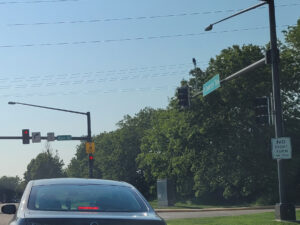InTrans / Jul 10, 2025
MnDOT study assesses No Right Turn on Red sign types
InTrans researchers’ project provides recommendations for use

Across the US, few studies exist on the effectiveness of dynamic No Right Turn on Red (NRTOR) signs, that is NRTOR signs that can be activated by time of day or by pedestrians to prohibit drivers from turning on a red light.
The Minnesota Department of Transportation (MnDOT) was interested in adding to the literature by studying the difference between dynamic and static NRTOR signs in terms of driver compliance and operational and maintenance needs, as well as adopting strategies to optimize the use of the dynamic sign type.
The recently concluded MnDOT research project, led by Institute for Transportation (InTrans) Research Scientist Chris Day—an expert in traffic signal operation—provides recommendations for adoption of dynamic NRTOR signs and guidance on which sign type may be preferred at a given intersection.
“This study is, to my knowledge, the first to examine NRTOR compliance rates at intersections where the dynamic NRTOR treatment has been in use for a long time,” Day said. “In addition to driver compliance, the study also examined maintenance requirements for dynamic NRTOR.”
The Iowa Statewide Urban Design and Specifications (SUDAS) Design Manual provides general guidance on circumstances when local agencies may prefer to use either a static or dynamic NRTOR sign. However, the findings from this study may offer more specific recommendations for local agencies to select the preferred type at various intersections in Iowa as well.
The study, which included a review of 4,500 hours of video from intersections with dynamic or static NRTOR signs in Minnesota, found more driver compliance with the static signs. However, anecdotal observations suggested drivers obeyed the dynamic signs when a pedestrian was present but turned once the path was clear even if the sign was still activated, suggesting that the dynamic NRTOR signs appeared to alert drivers to the presence of pedestrians compared to intersections without any sign.
“One advantage of using dynamic NRTOR signs is that the conditional display of the sign means that it is not necessary to prohibit the movement when there are no pedestrians present,” Day said. “This improves intersection efficiency by allowing right-turning traffic to proceed when there is a gap in cross street traffic while still drawing some attention to pedestrians.”
Recommendations in the final report offer sign type guidance based on an agency’s ultimate objective, whether it aims to improve NRTOR compliance, increase pedestrian safety, or create gaps on the crossing street. The report also provides guidance on improving the efficacy of dynamic NRTOR signs.
In addition to a literature review and the video assessment, InTrans researchers also conducted a survey of transportation agency staff across the US that found that the maintenance requirements for dynamic NRTOR signs do not appear to be burdensome.
“From a maintenance perspective, the static sign is the easier option, yet dynamic NRTOR signs do not seem to be especially problematic to install or operate according to the results of the practitioner survey,” Day said.
Additional findings and recommendations from the final report and research summary are available on the InTrans project page.
